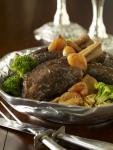
BUY COOKING JEWISH by clicking here now.
Summer's here - how about some ice cream?
You adored it as a kid, but you’ve never outgrown it. Here are two words that make everyone’s eyes light up – ice cream!
“In the store-bought category there’s good, not so good and really bad,” said food writer and consultant Peggy Fallon, author of “The Best Ice Cream Maker Cookbook Ever” (HarperCollins) from her Northern California home. Ice cream maker? Do I need yet another unused appliance taking up space on my counter, I wondered.
Then I leafed through the book and I was smitten. Chocolate Pumpkin with Hazelnuts. Peaches ‘n’ Cream. Double Ginger. Utterly Peanut Butter with a whole cup of peanut butter in a quart of ice cream! But with so many even gourmet ice creams available today, why would I want to make my own?
“I think the appeal of homemade ice cream, sorbets and frozen yogurts is that you control what goes into them,” Fallon noted. “There are so many odd ingredients in most supermarket ice cream. Just look at the labels. When you make your own, you use real cream, eggs, sugar and milk. If you’re concerned about what you put into your body, it’s better to eat real food.”
Sounds great, but I’m thinking, remember that bread machine you couldn’t live without and the havoc it played with your waistline?
Then I read on. A chapter called “On the Lighter Side” offers mouthwatering light ice creams, frozen yogurts, granitas and sorbets with alluring titles such as Maple Crunch Light Ice Cream, Tangy Orange Iced Buttermillk, Honey Vanilla Frozen Yogurt and Pear Sorbet with Zinfandel and Fresh Basil. Read the whole story
“It doesn’t always have to be a high-fat experience,” Fallon explained. “You can get the same satisfaction. I read in the New York Times just the other day that this new plethora of low-fat ice cream we’re seeing today contains fish emulsions, carrageenan and all kinds of bizarre things they have to use to keep the calorie count down. By making it at home there are no preservatives.”
Somehow I just can’t picture myself on the front porch hand-cranking ice cream. For starters I don’t have a front porch! “Somewhere people are still hand-cranking, but it’s not for me,” agreed Fallon. “Cranking will just make you cranky. Unless you’re Amish, I’d go with the electricity.”
When it comes to ice cream makers, there are lots of choices. The first generation of machines, by White Mountain, for example, does the cranking for you. The canister is surrounded by ice and rock salt, lowering the temperature of the ice cream as it churns and freezing it in about a half-hour.
Then there’s a machine that requires you to freeze the canister for 24 hours. “And they do mean 24 hours,” Fallon warned. “If you hear any gel sloshing, it’s not going to work. This can slow you down, but if people are ice cream-making fools, you can buy extra canisters, if you have the luxury of freezer space. I’ve seen a Cuisinart version at Costco for about $50.”
Cuisinart also makes a newer self-contained unit with a compressor in the machine so you don’t have to put anything into the freezer. “It used to be you’d have to buy an expensive imported Italian machine that would cost as much as your first car,” Fallon quipped. “But they’ve come down in price, and more manufacturers are getting involved. You’re going to be seeing a lot of homemade ice cream.”
APRICOT SORBET D’ELISHA
From “The Best Ice Cream Maker Cookbook Ever” by Peggy Fallon
2 (16-ounce) cans apricot halves in heavy syrup
3/4 cup sugar
2 tablespoons fresh lemon juice
1 tablespoon amaretto or brandy
1. Drain apricots, reserving 1/2 cup of the syrup.
2. In a food processor or blender, puree apricots until smooth. Transfer to a large bowl.
3. Add reserved 1/2 cup syrup, sugar, lemon juice and amaretto to apricot puree. Whisk to blend. Cover and refrigerate until very cold, at least 2 hours or up to 3 days.
4. Whisk mixture to blend and pour into canister of an ice cream maker. Freeze according to the manufacturer’s directions. Transfer to a covered container and freeze until firm, at least 1 hour or up to 3 days. Makes about 3 cups

